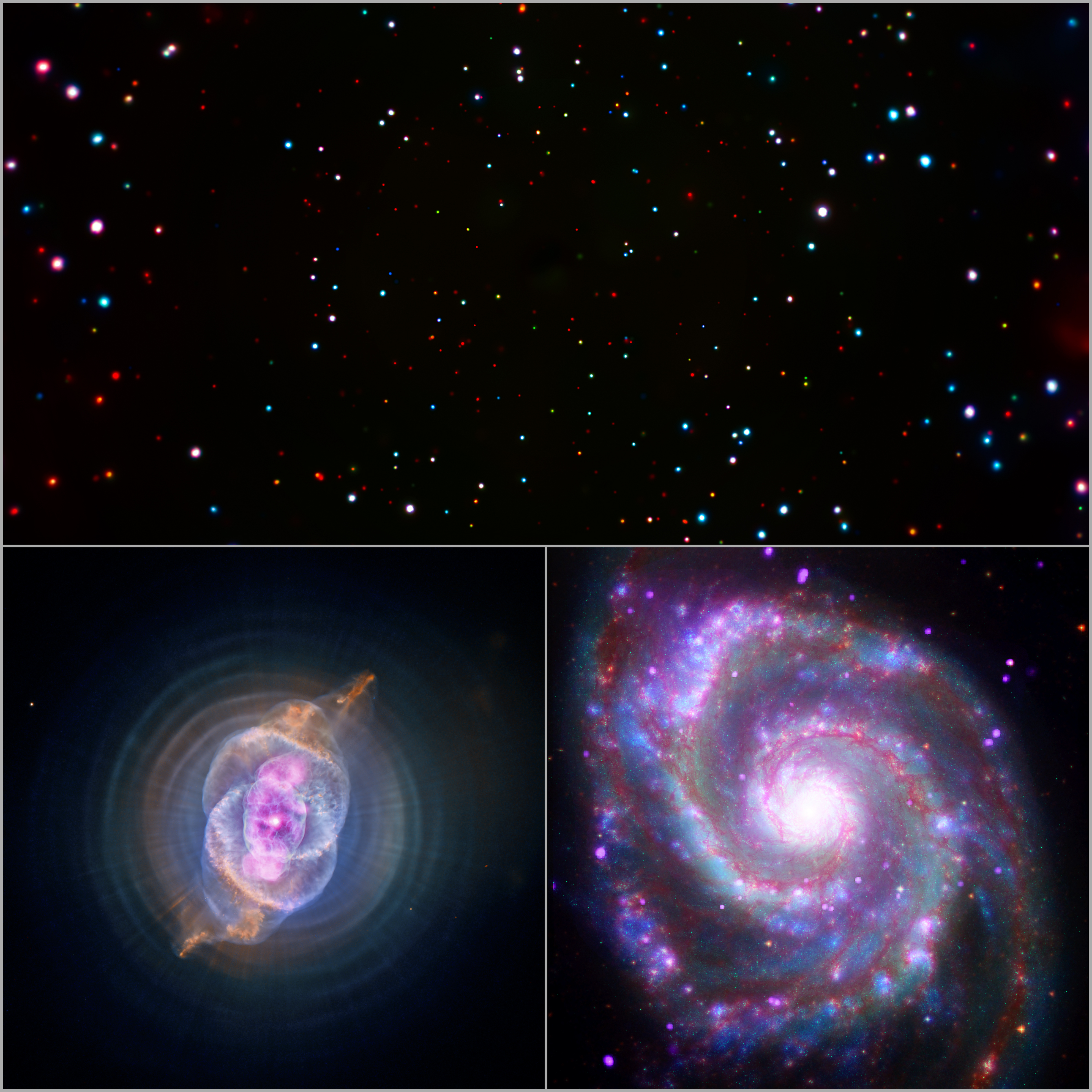Take a deep listen to these celestial-inspired sounds from NASA (Videos)
These musical videos illuminate different dynamics at play within iconic celestial objects.
A unique astronomy-music project has transformed NASA spacecraft data into celestial sound baths in a set of new videos.
On Wednesday (March 24), NASA released three videos made by a collaboration of its Chandra X-Ray Center (CXC) and the science outreach program SYSTEM Sounds. The videos blend the light data from the Hubble Space Telescope, observations taken by NASA's Chandra X-Ray Observatory and other spacecraft, and display them with unique and stunning audio and visuals.
In the videos, you can listen to the subtle, sparkly and sweet sounding interpretation of the Chandra Deep Field South, the cascade of the Cat's Eye Nebula and the friction of rubbing frequencies for Messier 51.
Related: This is what a supernova sounds like, according to NASA
The video project was helmed by visualization scientist Kimberly Arcand at CXC, astrophysicist Matt Russo (who gave a 2018 TED talk about data sonification) and musician Andrew Santaguida from SYSTEM Sounds.
Data sonification is equal parts artistic endeavor and science communication.Light and sound are different, but can be tweaked in audio or visual materials to deliver different types of information.
Light is composed of electromagnetic waves, which do not need a medium to travel: that's why the light from faraway stars can reach Earth, traveling through the emptiness of space. Sound, on the other hand, is made of mechanical waves, which means it needs to travel through a material, like water or gas, to exist.
Breaking space news, the latest updates on rocket launches, skywatching events and more!
Although sound may not literally be able to reach human ears from these distant celestial objects, transforming data into sound can alert the brain to relationships between different wavelengths on the electromagnetic spectrum by using musical intervals to represent differences or similarities in the data. The creators of this project highlight different elements in each of the videos.
The Chandra Deep Field South is the deepest image ever taken in X-rays, and the colored dots represent galaxies or supermassive black holes that live at the centers of galaxies. The full range of X-ray wavelengths present in this field is massive, so to depict them for our eyes, scientists used red for low-energy X-rays, green for medium strength and blue for high-energy X-rays.
These sounds take the one-dimensional color field and transform it into a phenomenological experience where sound transmits energetic differences.
"Played as sound... the full range of data can be experienced," NASA officials wrote in the press release describing the videos.
The stereo position of the sounds also helps the viewer to know if a pitch corresponds to a color on the left or right side of the image.
Related: Stunning images from Hubble, Chandra, and more
There's a "flying-through-space" feeling that comes from the data-sonification video made of the Cat's Eye Nebula. That's because the sound in this video illustrates what is happening at different distances from the spectacular nebula's center.
A radar-like scan moves clockwise. The brighter light observed by Hubble is louder, and the light found farther away from the nebula's core is at a higher pitch.
"The rising and falling pitches that can be heard are due to the radar scan passing across the shells and jets in the nebula," wrote NASA officials. X-ray data from Chandra are depicted using what NASA described as a "harsher" sound.
The dissonant sounds from the data sonification of galaxy Messier 51 depict observations from Hubble, Chandra, NASA's former infrared space telescope Spitzer and the space agency's former ultraviolet telescope GALEX. Like the Cat's Eye Nebula video, the sound here follows an animated radar line dragging clockwise across the face-on oriented galaxy.
Messier 51 is popularly known as the Whirlpool Galaxy and, fittingly, the music delivers a sonic bath of tensely-related pitches that correspond to infrared, optical, ultraviolet and X-ray light. The short and bright sounds correspond to the compact spots of light seen occasionally along the galactic arms.
"At wavelengths in which the spiral arms are prominent, the pitches creep upwards as the spiral reaches farther from the core. A constant low hum associated with the bright core can be heard, punctuated by short sounds from compact sources of light within the galaxy," wrote NASA officials in a video description.
Previously, SYSTEM Sounds has put music to the Pillars of Creation, the TRAPPIST-1 exoplanets and the Helix Nebula. More of their videos are available to view here. The Harvard and Smithsonian Center for Astrophysics in Cambridge, Massachusetts runs the Chandra X-Ray Center (CXC) for NASA.
Follow Doris Elin Urrutia on Twitter @salazar_elin. Follow us on Twitter @Spacedotcom and on Facebook.

Doris is a science journalist and Space.com contributor. She received a B.A. in Sociology and Communications at Fordham University in New York City. Her first work was published in collaboration with London Mining Network, where her love of science writing was born. Her passion for astronomy started as a kid when she helped her sister build a model solar system in the Bronx. She got her first shot at astronomy writing as a Space.com editorial intern and continues to write about all things cosmic for the website. Doris has also written about microscopic plant life for Scientific American’s website and about whale calls for their print magazine. She has also written about ancient humans for Inverse, with stories ranging from how to recreate Pompeii’s cuisine to how to map the Polynesian expansion through genomics. She currently shares her home with two rabbits. Follow her on twitter at @salazar_elin.

